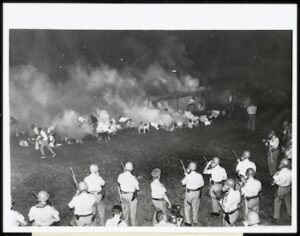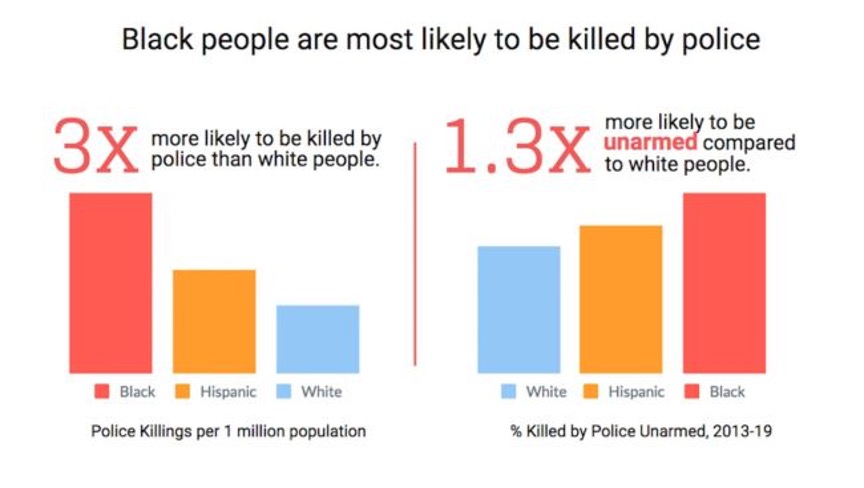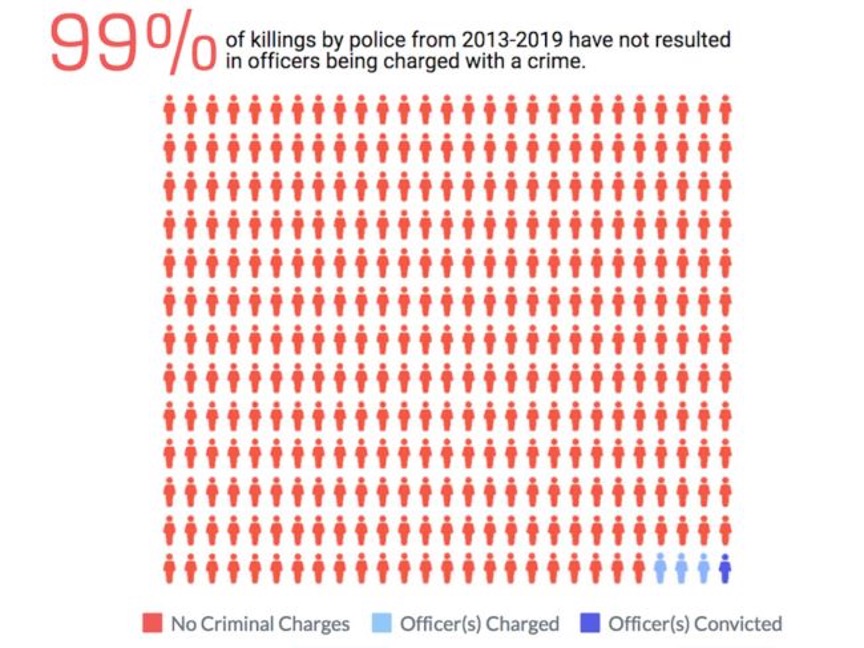
Black History and American Police Brutality, 1966
*Black history and American police brutality are affirmed on this date in 1619. The expendable pattern of Black lives intersecting with American law enforcement did not begin with Tamir Rice, Michael Brown, Brionna Taylor, or George Floyd.
To understand the systemic racism embedded in American police forces, you must look back at the racial order in the United States and the reason this exists in the first place – slavery. Professor Douglas J. Flowe says: "America was founded upon the principle of reducing Africans to subhuman chattel, and much of America's early culture was about solidifying that principle, and maintaining psychologically and physically, for all Americans; it is naïve for anyone to believe that the tremendous centrifugal force of that arrangement could somehow evaporate as soon as slavery ended." Since the abolition of slavery, stereotypes of Black people, in particular Black men, have existed – they have been "portrayed, deliberately as a dangerous, violent threat,"
Dr. Tom Davies explains: "The widespread phenomenon of lynching was about striking fear into the hearts of African Americans and 'keeping them in their place,' showing them how white supremacy would work, making clear the idea that black freedom – be it political, economic, social - wouldn't be accepted." "A big part of trying to intimidate and control the black community involved both demonizing and brutalizing black men, first and foremost." The stereotype of 'seeing a black man as a 'threat' is a long-standing image in American political and social history." This Trope remains a coded value that began with the 19th-century Ku Klux Klan, the vigilantes that set the tone for policing in America. When a police officer stops a black person, they are more inclined to be more aggressive – black people are three times more likely to be killed by police than white people.

Credit: mappingpoliceviolence.org.
The Klan's organized terrorism began on March 31, 1868, when Republican organizer George Ashburn was murdered in Columbus, Georgia. Over the following months, Klan-inspired violence spread throughout Georgia's Black Belt and into the state's northwestern corner. Klan action was designed to intimidate Black voters and white supporters of the 19th-century Republican Party. Klansmen paraded on horseback at night, dressed in outlandish costumes, or threatened specific Republican leaders with violence. Increasingly, during 1868, these actions became violent, ranging from whippings of Black women perceived as bold to the assassination of Republican leaders. It is impossible to untangle local vigilante violence from political terrorism by the organized Klan, but attacks on Blacks became common during 1868. Freedmen's Bureau agents reported 336 cases of murder or assault with intent to kill on freedmen across the state from January 1 through November 15 of 1868.
In the early 20th Century, the country saw a massive revival of the Klan, which would count several million people among its ranks at its height. This is what happened in Long Beach, CA., where the Klan's resurrection bubbled up from the local Christian temperance movement that seized upon the anxieties of White Protestant Midwestern transplants, writes local historian Claudine Burnett in Prohibition Madness: Life and Death in and Around Long Beach, California 1920-1933.
Fear that the "sins" of bootleggers and flappers were destroying the nation's moral fiber begot an "America for Americans" mindset that subordinated nonwhites and anyone perceived to be unpatriotic. In 1922, one of the hate group's officers told a Daily Telegram reporter, "that the Ku Klux Klan is one of the purest, noblest, cleanest, most Christian, most patriotic organizations that had ever come into existence." During this time, the Klan had an office at 1630 E. Anaheim St., in Cambodia Town. From there, they mounted right-wing populist appeals to Long Beach's White working-class with rhetoric pushing the idea that they, not immigrants, deserved jobs in the city's booming oil industry, writes Letticia Montoya in The Ku Klux Klan in Long Beach, a Cal State Long Beach research paper held by the city's historical society. To protect Klan interests, the local KKK chapter successfully recruited city officials, including police officers.
The facts were evident in the 1960s with constant law enforcement assault on the Black Panther Party. Another testimony to this occurred in the 1981 police killing of Ron Settles, a student/athlete at Cal State University, Long Beach. "By day, some Klansmen exchanged their hoods and sheets for blue coats and badges as Klan membership was trendy in the Long Beach Police Department," then-graduate student Billy Norfleet Jr. wrote in a 2004 article for the now-defunct Long Beach literary journal, The Southlander. "Indeed, the Klan headquarters on East Anaheim Street and the cross-burning ceremonies at Recreation Park … made Long Beach a 'tough place for Blacks.'" "There has been a habit of explaining black death at the hands of police officers as tragic, but necessary to keep the public safe," Professor Flowe explains.
But in a country where police officers face little to no consequences for their actions, 99% of killings by police from 2013-19 have not resulted in officers being charged with a crime – there is no disincentive for an officer to draw his gun. In August 1972, thirteen Black police associations and 109 Black peace officers met in St. Louis, Missouri, to establish the National Black Police Association (NBPA). Their mission is: "To increase the awareness of the community, to be the conscience of the Criminal Justice System, and to enhance the quality of life in the African American Community."
In 1992, four white officers were found not guilty in the beating of Rodney King; though fired, no officer has been charged in the death of Eric Garner. The Supreme Court created a legal doctrine around 40 years ago that shields law enforcement and government officials from accountability for constitutional violations like the right to be free from excessive police force. The legal doctrine protects government officials from liability for conduct on the job unless they violate "clearly established" constitutional rights.

Credit: mappingpoliceviolence.org
Protesters have also been calling out the militarization of the police and the use of military equipment, which began under President Ronald Reagan. In the 1980s, the militarization of the police grew in the context of the War on Drugs, which directed police officers to arrest people on drug charges. The Anti-Drug Abuse Act of 1986 gave billions to wage this effort and encouraged mandatory minimum sentences for drug offenders. The police did not go to college campuses where drugs were widespread; they targeted Black communities. "This again is another chapter in the history of police treating Blacks differently to Whites." Prof Flowe says: "The War on Drugs was fought primarily in poor and working class, and Black inner-city neighborhoods. "White spaces, such as college campuses – were left alone. They targeted people with the least social capital or economic potential to defend themselves legally."
This helped to further fuel tensions between poor, working-class black communities and the police – and made "our communities feel like war zones." Police forces failed to understand that crime is systematic. If you are born into an impoverished, predominantly Black urban center with few jobs, people rely on welfare, and children attend poorly funded public schools. Crime can quickly arise from these social conditions. Dr. Davies explains that this "cyclical problem, tied to long-standing discrimination in housing, employment, education, and healthcare," has created "pronounced poverty in parts of the US" where police brutality is often the worst. Another viewpoint to halt the brutality of police in Black communities is to blend 'human rights' and 'civil rights.' There is a lack of understanding of "the impact of society and economic isolation in a capitalist country as a factor of crime." Prof Flowe says: "They have focused on punishment and policing, rather than systemic changes for equality."
In 2016, this only increased under President Donald Trump, who urged law enforcement officials to "dominate" protesters and has called for a more forceful approach. American civil rights and human rights are blurred regarding police brutality. This is primarily due to the branding of law enforcement as a municipal entity that ‘protects and serves’ the community. Colin Kaepernick protested this hypocrisy in 2016. The case of Elijah McCain in Denver, CO, resulted in the conviction of the police officer.
In the wake of George Floyd's killing, legal experts call on the Supreme Court to rethink 'qualified immunity' as they believe the standard victims must meet to hold law enforcement accountable has become exceedingly difficult to reach. However, racially motivated police brutality is not confined to white officers. On January 7, 2023, Tyre Nichols (a Black man) was fatally beaten by five Black Memphis police officers. Finally, connecting Black history and restorative justice is gaining traction to offset the punitive history that police brutality has with Black people in America.
To Become a Policeman or Detective
To become a Probation Officer
Image: Collection of the Smithsonian National Museum of African American History and Culture, Gift of Howard Greenberg Gallery